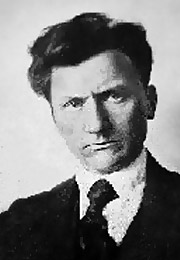


Bronze
79.4 x 52 x 26 cm. (31 1/4 x 20 1/2 x 10 1/4 in.)
L.1988.62.64
[Possibly Marie Harriman Gallery, New York, by 1939]. Henry Pearlman, by 13 Jan. 1955; Henry and Rose Pearlman Foundation, by 1959.
A portrait of Lehmbruck’s wife, this is one of many bronze casts made from the models inherited by the artist’s family after his suicide. Bust of a Woman is based on a fragment of Standing Woman, Lehmbruck’s first successful composition after his arrival in Paris and one that signaled the artist’s liberation from the style of Auguste Rodin, the dominant sculptor of the time. Younger artists like Lehmbruck found Rodin’s figures overwrought in pose and expression.

Wilhelm Lehmbruck (1881-1919)
One of the leading modern sculptors of his generation, Wilhelm Lehmbruck(1881–1919) developed a style that brought a new sense of naturalism and psychological depth to the human figure. His works proved highly influential for the following generation of German sculptors, and he gained renown in the United States in 1913, when a group of his sculptures was exhibited at the groundbreaking Armory Show in New York.
The son of a miner, Lehmbruck was born in Duisburg, Germany. From 1895 to 1901 he trained at the college of decorative arts in Düsseldorf, followed by five years with Karl Janssen at the fine arts academy. Lehmbruck’s earliest works—predominantly drawn nudes and anatomical studies—were conceived in a classical vein, although he also addressed contemporary subjects and distinguished himself with an innovative formal simplicity. Michelangelo’s work became a particularly important paradigm for the young sculptor, who visited Italy in 1905.
While working in Düsseldorf, Lehmbruck traveled to Paris in 1907. There, he was struck by Aristide Maillol’s highly sensual and rounded figures, which suggested a new direction away from the then-dominant model of Auguste Rodin. Lehmbruck decided to join the international avant-garde scene in Paris, moving to Montparnasse in 1910 and exhibiting at the Salon d’Automne the same year. He soon became familiar with the work of such avant-garde sculptors as Amedeo Modigliani, Constantin Brancusi, and Alexander Archipenko. Lehmbruck’s style underwent a dramatic change in 1911, turning to a much more expressionistic manner, featuring figures with elongated forms and a brooding, existential air.
Upon the outbreak of World War I, Lehmbruck was forced to leave Paris and moved back to Germany. Although he avoided conscription as a soldier, he worked at a hospital for dying and wounded soldiers, which caused lasting psychological devastation for the artist. In 1916, Lehmbruck fled to Zurich, where he created portraits and symbolic works that conveyed his profound despair. He returned to Berlin after the war and took his own life in 1919.